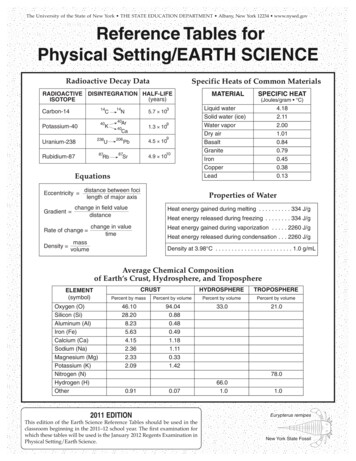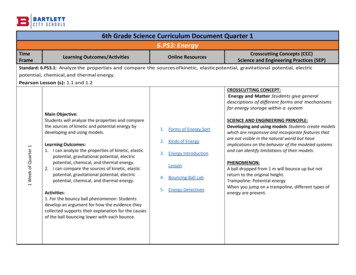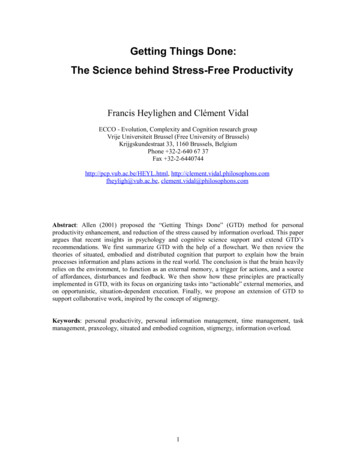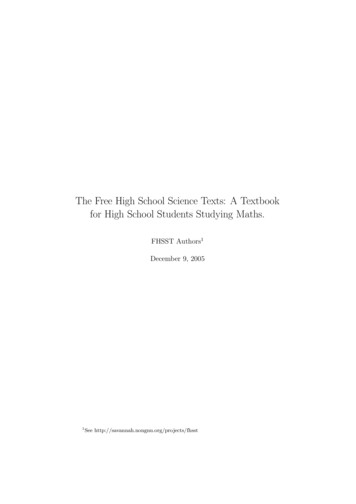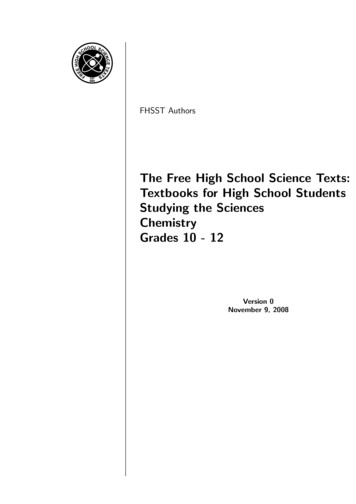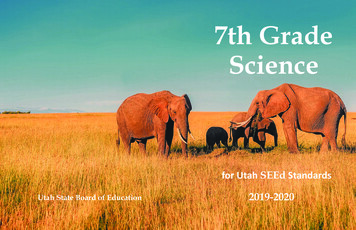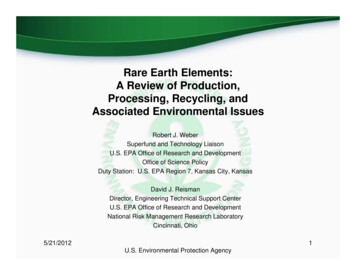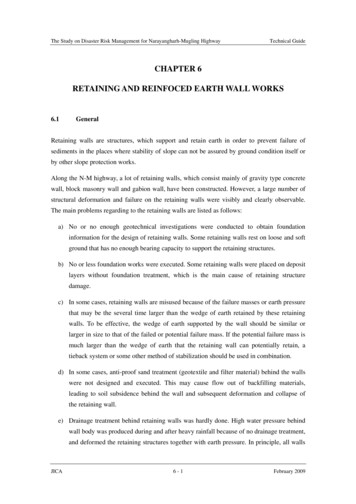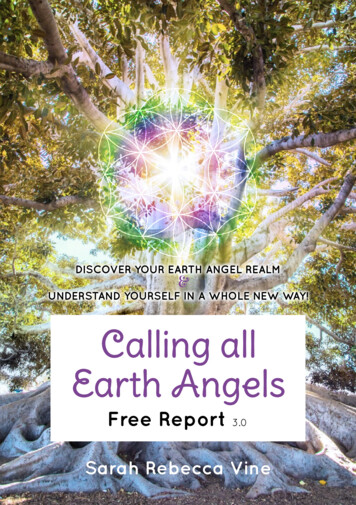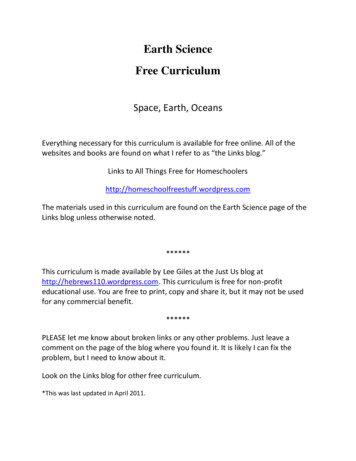
Transcription
Earth ScienceFree CurriculumSpace, Earth, OceansEverything necessary for this curriculum is available for free online. All of thewebsites and books are found on what I refer to as “the Links blog.”Links to All Things Free for comThe materials used in this curriculum are found on the Earth Science page of theLinks blog unless otherwise noted.******This curriculum is made available by Lee Giles at the Just Us blog athttp://hebrews110.wordpress.com. This curriculum is free for non-profiteducational use. You are free to print, copy and share it, but it may not be usedfor any commercial benefit.******PLEASE let me know about broken links or any other problems. Just leave acomment on the page of the blog where you found it. It is likely I can fix theproblem, but I need to know about it.Look on the Links blog for other free curriculum.*This was last updated in April 2011.
NOTESScheduling:I put a loose idea of how long you will spend on each main subject. You will need to plan out your time.Print out the curriculum and mark what things you plan on using. You can even just write a M forMonday, etc. next to the items and your planning is done. Check off what you do, then you have arecord of it! You don’t have to do it all. Pick what reading and activities work for your family. If you havehigh schoolers, especially seniors, you may want to use one of the courses I have listed.This is written so that all of your children can study together. They can learn the same topics but usedifferent levels of reading materials. The materials are divided up by level. These are my approximationsonly. L means K-2nd or 5-8 year olds. M means 3-6th or 9-12 year olds. U means 7th and up or teenagers.Older kids can use younger sites for fun and to get an overview of a topic before reading hardermaterial. Younger kids can have an older kid read and explain to them. A blank lapbook piece can hold apicture, a word or a paragraph. My point is: don’t just assume you can’t use something if it’s labeled fora different age group, especially if it’s labeled M, maybe it could go both ways. However, somethinglabeled M-U probably isn’t going to work for younger students. Something labeled L probably is tooyoung for your older students.Preparation:Before you begin each section, print out everything you think you will be using and place it in yourbinder. Hand out the papers to your kids as you need them, and then the papers are ready to go rightinto their binders when you are done. If you do notebooking and lapbooks, consider cutting your filefolders in half and putting hole punches in them. Put the lapbook pieces on the half folders and keepthem in the binder with their notebooking pages on the same subject. Of course, your younger kids likehaving a complete lapbook to carry around and look at and share.Even before you begin the school year print out lots of blank notebooking pages (if you use them) andalso experiment notebooking pages. Make sure you always have them on hand.What to do each day:Lapbooks: There are several lapbooks in here. You can use them to guide your study and get a piece ortwo done each day. You can print one for each child or have them work on separate lapbooks (one doestropic oceans one does temperate oceans and then teaches the other their topic when they finish). Youcould also have them work together doing separate pieces on the same lapbook or by having oneresearch, one write, etc. Older students could do a notebooking page on the topic of the younger child’slapbook piece. There are lots of blank lapbook pieces and notebooking pages available on the GeneralResources page of the Links blog. Print out a bunch and have them on hand in your binder.You could also record what you learned each day by using power point (there is a free version of thisfrom Open Office) or by making a digital notebooking page on something like Glogster. On Glogster youdon’t have to print out what you make, you can publish it online. This can be a nice option.
When you do an experiment, take the time to have your child write up an experiment page. There arenotebooking pages for this on the Science page. Write out the question you are trying to answer, yourmaterials, procedure, observations and conclusions. If you have a variety of ages, have a groupdiscussion and have an older child write as the younger children tell what you used and how you did it.
There are several options for online curriculum for high school students.Senior There is an AP course in Environmental Science. This is from Hippo Campus.Senior There is also an online “virtual” textbook on Geoscience. This is also for senior students.UThere is a high school curriculum online in geology by Answers in Creation. This is Christian, asopposed to the others, but it is OLD earth, meaning they don’t believe in a six day creation.UThe JASON Curriculum is a neat website. This is especially good if you have a child interested inbeing a scientist. The curriculum is narrated by scientists and there are videos by teens whohave gone and learned from them. There are all sorts of resources and curriculum on varioustopics such as weather, earth, mars, ecology and geology. There are online virtual textbooks andlabs as well as worksheets and teacher’s guide. My 8-year-old son loves this website. The info isabove him, but he loves the digital labs. Some of their activities I link to specifically underdifferent topics, but there is more on the site than I have specifically listed on the blog.
Space 2 months If you believe in a literal six-day creation, you might want to start your time with the links from 4th DayAlliance with their articles on evidences of a young universe and with the links of Ken Ham’s differentcreation talks.M – U Online Astronomy Course – there are two groups for these courses, so you can pick what’s mostappropriate. I have only seen the 7-11 year old one. It was a short reading each day with aquestion, set of questions or activity to do. It says each packet (there are 8) should take a week.Your child could easily do it in half the time. A lesson can be done in ten minutes.LapbooksThere are four choices of lapbooks. Including ones based on Apologia and on a Magic School Bus chapterbook. You could easily do the piece-or-two-a-day-approach and work through a lapbook. The lapbooksare for elementary and middle school. I had a hard time finding lapbook pieces appropriate for mykindergartner. With all the other lapbook choices I listed the link to my homeschool blog where I showwhat I used with my 5 year old.The Sun LearnL-MBook about the sunL-MSun, Moon, Earth online interactive gameL-M-U Relative size of the sun DoM-UBuild a model of the sun (the U version of this has a sun facts book that goes with it, verydetailed)M-UObserve sunspotsUBuild a sundial out of paper
The MoonL-M-U Learn about the moon’s phases with one of the links and use the graphicorganizer to show what you learnedSpace Exploration under “Exploration”Lapbooks:LAstronauts lapbookMSpace Shuttle lapbook Learn about space shuttle missionsL-M-U Read about Apollo 11 and the history of space explorationL-MWatch videos on space missionsL-M3-2-1 Liftoff, NASA lessons for K-4 (lots here: you’ll need to choose)M-UWatch a video: The Case of the Great Space Exploration DoL-MBuild your own space mission online activityUVirtual shuttle launchM-UNASA hands-on projectsL?-M-U Build a rocket out of tortillas activityL-M-U Build a Rocket (L can help and observe, but they can’t do this on their own)M-UVideo The Case of the Great Space Exploration (1 hour) OtherL-MRead-online picture books about NASA toolsL-MInternational Space Station Online activities/worksheets NASAMSatellitesMSpiderbot
Planets (you will find some of these under Astronomy Mathematics) LearnLLearn about the planets online gamesL-MWhat’s in Space/ Book on the planets, two online children’s books, NASAL-M-U Relative size of the planetsL-M-U Learn about the planets with NASA’s interactive mediaL-M-U Learn how much you would weigh on each planetL-M-U Learn how old you would be on each planetMArticle on the status of PlutoM-UWatch video: The Case of the Galactic Vacation (1 hour) DoLSolar system coloring pageL-MMake a graph of how many moons each planet hasMFlight path coordinate plane activityM-UPlanet trading cards and online activitiesL-M-U Solar System craft project ideas (links)What Else Is in the Solar System M–ULearnAsteroidsL-M-U Comet experimentM-UComets online interactive activities to learn what comets are made ofUComets – NASA’s pageL-M-U Deep space photo galary
MDeep space read about and online activitiesM-UBlack holes online interactive DoL-M-U Comet experimentM-UBlack holes board gameConstellationsLDot to dotL-MConstellation strips (pictures of the constellations – could use in lapbook)L-MMake a big dipper mobileMNotebooking pagesM-UStar finder – map of sky (2 different ones)UMake a planisphereThere are many other mathematics activities if you are interested in pursuing them. They are for variouslevels and are listed under astronomy mathematics.
The Earth (3 months)MLayers of the Earth (read, listen to song)M-ULabel the layers of the earthBiomes L-MLearnWebsite for all the biomesL-M-U Desert websiteL-M-U Rain Forest websitesL-MWetlands online activityUWetlands activity DoL-M-U Make a diorama of each biome (different kids could do different ones)L-M-U Make a map of where each biome is located in the world (this activity is in the lapbook below)L-M-U Biomes Lapbook (find and fill in most important info on each biome listed-links included)L-MRain forest lapbookL-MStar in a rain forest storyMAmazon Explorer (maybe everyone would enjoy this)M-UWrite a persuasive paper or a speech about why we need to protect the rain forest (or any ofthe biomes)
Earthquakes LearnL-M-U Earthquake unit (lessons, worksheets)M-URead all about earthquakesM-UWatch Video, The Case of the Shaky Quake (1 hour)L-M-U Look at pictures from past earthquakes to learn about the different rating scales DoL-MEdible experiments (two of them) These are simple.UBuild a paper model of an earthquakeLandformsL-M-U Landforms worksheet/lapbook pieces – answer the questions/define the terms/match thepictures to definitions (mountains, caves, volcanoes are included –plus many more) This is aworksheet, but just cut them out and they become lapbook pieces. Learn the definitions of thedifferent terms (peninsula, delta, etc.) and place the lapbook pieces on a world map where theycan be found. Volcano goes on Japan for Mt. Fuji for example. Caves can go on India; mountaincan go on Everest. Or just label the landforms on your map. You can find large world maps onthe history/social studies page. I suggest printing out the biggest possible.MMountains mini book for a lapbookL-M-U Caves online tour/activitiesMGlaciers online learning site VolcanoesL-M-U Volcano unit (Homeschool Learning Network)L-MVolcanoes lapbook/unit (Homeschool Creations)L-MBecome a volcanologist (learn about the different types of volcanoes)MVolcanoes websiteL-M-U Build a volcano (out of dough or paper)UWatch a volcano documentary
RocksMMagic School Bus Rocky Road Lapbook LearnL-M-U Learn about rocks and mineralsM-ULearn the characteristics of the three types of rocksL-MLearn about different kinds of rocks (2 separate links)L-M-U If you want, there are flash cards of different rock types. M-UDoBuild paper mineral crystalsL-M-U Collect rocks and identify them. Use one of the “My Rock” worksheets to record yourobservations and you work to identify your rock. Use the “Identify the Kind of Rock You Found”link. You could also use one of the checklists if you want to find lots of rocks and keep track ofwhat you’ve found. You could spend at least a week doing this, filling out a worksheet each day. Learn the Rock CycleL-M-U Print out a diagram of the cycle.L-M-U Watch the online animations of the cycle. (There are three.)L-M-U Listen to the rock cycle song.M-UWatch a video on erosion. The Case of the Disappearing Dirt (1 hour)L-M-U Make a diagram of the rock cycle. (You can do it yourself, or download the pdf.)M-URock Cycle worksheet. Do they know the answers? Can they explain the diagram?
Weather (2 months )Chart the weather.LWeather coloring picturesLDate and weather chartL-MWeather graphUOlder students can record the weather daily (or twice a day) and record not only the conditionsbut the cloud type at the time as well. Do they see any correlation between the cloud type andthe weather? They can create a chart of their weather observations over a couple of weeks.They can build a weather station (below) and record not only conditions and temperature butthe air pressure and wind direction as well. Have them use this information to predict the fiveday forecast (below).Temperature LearnL-MSeasons and TemperatureM-UGraphic organizer for the causes of the seasons MDoHow High Is the Sun? Online activityAtmosphere LearnL-MTree House Weather Kids – air pressure and cloudsM-UThe Atmosphere (website) M-UDoLabel the layers of the atmosphereL-M-U Cloud experimentL-M-U Air pressure experiments (L can just watch, one requires a lighter or match)
L-M-U Print out the cloud matchbooks. Place in a lapbook or binder or hang them up near a windowwithout cutting them out. Write the date on the blank part above each picture when you seethat type of cloud.The Water Cycle LearnL-MRead “Rain”M-URead “The Water Cycle”L-MWatch the water cycle animated lessonM-UWatch “The Case of the Wacky Water Cycle” 1 hour DoL-M-U Evaporation experimentL-M-U Make rain experimentL-M-U Water cycle experimentL-M-U Capillary action experimentLWater cycle online quizM-UFill in (or make your own from scratch) water cycle diagramForecasting LearnM-UEdheads online game (three levels)M-URead about forecasting DoL-M-U Make a weather station (including wind vane, and the barometer listed under Atmosphere)L-M-U Calculate/Find th
L Solar system coloring page L-M Make a graph of how many moons each planet has M Flight path coordinate plane activity M-U Planet trading cards and online activities L-M-U Solar System craft project ideas (links) What Else Is in the Solar System Learn M–U Asteroids L-M-U Comet experiment M-U Comets online interactive activities to learn what comets are made of U Comets – NASA’s page L-M .
